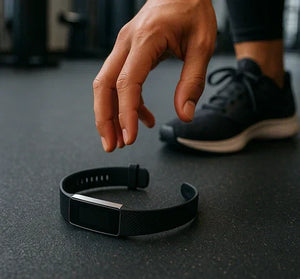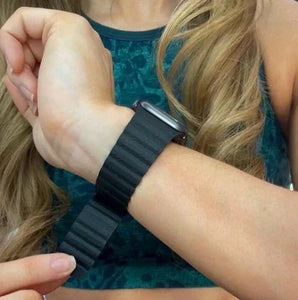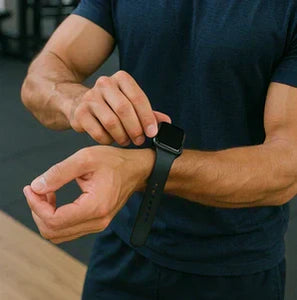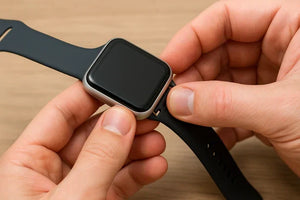Is your watch band for your Apple Watch giving you grief? Maybe it’s loose, stuck, or just not clicking right. Don’t worry, though, we’ve all been there. The good news? You don’t need to rush to the Apple Store or buy a new one straight away. With a few quick checks and some simple fixes, you can sort most strap issues in a matter of minutes. So, let’s walk through what’s going wrong and how to get your strap back in shape, quickly.

Figuring Out What’s Actually Wrong
Before you dive into fixing anything, let’s suss out what’s really going on. Most strap issues come down to one of three things: the connector, the button, or the strap itself.
First of all, take the watch off your wrist. Hold it up and have a proper look.
Try sliding the strap out gently. Does it move freely, or does it feel stuck halfway? If it’s catching, the release button might be jammed with dust or sweat residue.
Next step, check the locking end. Slide it in and out of the slot a few times. It should click in cleanly, that satisfying snap when it locks into place. No click though? You might have worn or bent connectors.
Now take a quick look at the strap material. Silicone bands often stretch after a while, especially if you wear yours tight. Leather cracks or warps when it gets damp. Metal straps can loosen around the links or the pins.
If the issue is mechanical, it’s usually fixable with cleaning or a gentle adjustment. But if the band’s split, frayed, or just falling apart, no amount of tech magic will bring it back.
This quick check saves you time and keeps you from fixing the wrong thing. Once you know what’s up, you can jump straight to the solution.
Cleaning the Watch Band Might Be the Hidden Fix
Here’s the cold, hard truth: most watch strap problems Apple users come across are not actually about broken parts. They are about grime. Sweat, dust, and skin oils sneak into the connector slots and jam the mechanism. A quick clean is the trick that often sorts it right out.
Start by removing the strap. Hold down the release button and slide the band out gently. Don’t yank it too hard if it is really stuck; wiggle it side to side until it loosens.
Once it’s off, give it a proper look. You will most likely spot a fine layer of dirt along the edges or around the connection point and connector rail. That’s your culprit, right there.
Now, grab a soft, lint-free cloth. Slightly dampen it up with some warm water, or a mix of water and a tiny drop of mild soap. Wipe the connectors on both the strap and the watch itself. For stubborn gunk, a dry toothbrush or cotton bud works wonders.
If it’s a silicone watch band, rinse it well and dry it completely. For leather, skip the water and use a dry cloth only, or a proper leather cleaner. And if you’ve got a metal link strap, focus on cleaning the joints where dust collects.
Once everything’s spotless, slide the strap back in. You’ll feel that crisp “click” again. Feels like new, doesn’t it?
Simple maintenance like this keeps your strap smooth, comfy, and ready for whatever your day throws at it.
Check out our full guide to cleaning silicone wristbands here.

When It’s a Hardware Fault, Not Just Dirt
Alright then, so you have cleaned everything up as well as you can, but the strap is still acting up. No worries, though, now we know that we’re talking hardware. This is where we roll up our sleeves a bit.
If your strap won’t lock in place properly, check the tiny metal connector on the band. Sometimes it gets slightly bent from pressure or a bad angle when putting it on. Lay the strap flat on a hard surface and look at it side-on. If it’s uneven, that’s your issue. You can gently nudge it back with a small flat tool, but be careful though. Push too hard and you will bend it more.
If the release button feels jammed, try pressing it a few times while sliding the band in and out. Still stiff? A tiny bit of rubbing alcohol on a cotton bud can help clear sticky residue. Avoid soaking it, just dab it. That usually frees it up straight away.
When you’re dealing with a cracked or split strap, it’s time to be honest: that one’s done. Silicone tears can’t be glued properly, and damaged leather never feels the same again. Replace it. Otherwise, you will risk the strap snapping while you’re wearing it.
And here’s a quick heads-up, though: don’t use metal tools on the watch body. One slip and you will scratch it. If something feels too tight or doesn’t move easily, stop. Apple Support or a local repair shop can take it from there.
Most of the time, though, it’s fixable. A small tweak, a bit of cleaning, and your strap’s back in business in no time, with no new parts and no fuss.
Choosing a Replacement Strap That Actually Lasts
Sometimes, fixing isn’t actually worth the hassle, though, especially if your strap is really torn, stretched, or just seen better days. In that case, getting a new one’s the smart move. But here’s the catch: not all straps are made equally.
Apple’s official straps are pricey, yes, but they’re specifically designed to be durable. The materials, the lock mechanism, the overall feel, everything fits exactly the way it should. If you are after reliability and a clean look, it is rare hard to beat the original.
That said, third-party options have come a long way. You will find loads that look great and cost a fraction of the price. Just don’t go for the cheapest thing on Amazon or eBay, as those often use weak connectors that don’t click in properly or wear out fast. Look for verified compatibility with your specific Apple Watch model, while thinking about your day-to-day life too.
-
If you’re into workouts or outdoor stuff, silicone or fluoroelastomer straps are perfect as they are sweat-proof while being lightweight.
-
For office or smart casual wear, leather adds that classy touch.
-
And if you like something sleek and modern, metal link or Milanese loop straps hit the spot to perfection.
Also, have a couple of straps on rotation. One for work, one for workouts, one for chill days. It keeps them all in better shape longer and lets you switch up your style without spending loads.
Pick quality once, and you’ll stop worrying about straps altogether. It is that simple.

Putting It Back Together The Right Way
You’ve cleaned it up, checked it, maybe even replaced it, now it’s time to clip it all back in. This bit seems simple, but doing it right makes all the difference.
Hold your Apple Watch face down on a soft surface so you don’t scratch it. Line up the new or cleaned strap with the groove on each side. You will see that each end only fits one way, so don’t force it. Slide it in gently until you hear, or feel, that little click. That sound means it’s locked in.
Give it a small tug. If it slides out, it’s not seated properly. Take it out, flip it around, and try again. It should move smoothly but stay firm once locked.
After that, put it on your wrist and check the fit. It shouldn’t feel too tight, just snug enough that the sensors stay in contact with your skin. If you’ve swapped to a different material, it might feel odd at first, but you’ll get used to it in a day or two.
And that's all it is. Quick, simple, and satisfying. There’s nothing like that smooth “click” when the strap snaps perfectly into place, you know it’s solid, and you’re all good to go.
When To Let The Experts Step In
Sometimes, no matter how careful we are, the strap just won’t behave. Maybe the release button’s jammed solid, or the metal lug looks slightly warped. That’s when you stop forcing it and call in the pros.
If the connector rail’s bent, don’t try to straighten it yourself. Those grooves are precise; one wrong move, and you’ll wreck the fitting. Apple techs have the right tools to sort that out without scratching or damaging the watch body.
If the button doesn’t move at all, it could be an internal spring issue. You won’t fix that at home with a cotton bud and hope. Drop by an Apple Store or a certified repair shop instead. They will check it, clean it out, or swap the component if needed.
And if you’ve got a premium grade strap, like a stainless steel or a fine leather, it’s worth getting it serviced properly. Reconditioning can bring it back to life for way less than buying a new one.
It’s not giving up, it’s being savvy. Some fixes need a steady hand and Pro Tools. Better to let someone who does it daily handle it than risk turning a small issue into a pricey one.
Keeping Your Watch Strap In Top Shape
Now that your strap’s sorted, let’s keep it that way. A bit of care goes a long way, and it takes barely any time.
First off, give it a quick wipe every few days. Sweat and skin oils build up fast, especially after workouts. A soft, damp cloth is all you need, nothing fancy.
If you have more than one strap, swap them around. Rotation gives each one a break and stops wear and tear from building up in the same spots. It also keeps things fresh; different straps equal different vibes.
Avoid chucking your watch down on hard surfaces or leaving it in the heat. Extreme temperatures and sunlight ruin both silicone and leather over time. And if you go swimming or hit the gym, rinse your band afterwards, especially the silicone ones.
Leather needs a bit more love. Keep it dry, use a small amount of conditioner every few months, and never soak it. It’ll last for years if you treat it right.
A clean strap looks better, feels comfier, and lasts way longer. Keep up the habit, and you’ll spend more time enjoying your watch and less time fixing it.
How To Fix Apple Watch Strap: Wrapping It Up
Fixing your Apple Watch strap doesn’t need to be a headache. Most issues come down to dirt, wear, or a dodgy connection point, all easy wins once you know what to look for. A quick clean, a careful check, or a quality replacement keeps your watch looking sharp and sitting snug. Stay on top of simple care, and your strap will last ages.
If yours is beyond saving or you fancy a fresh look, check out Fitstraps, order premium-quality Apple Watch-ready replacement wristbands at prices that will not make your wallet cry.
 Finding the Best Fitbit Band for Sleeping
Finding the Best Fitbit Band for Sleeping
 Finding a Christmas Apple Watch Strap: Celebrate the Season in Style
Finding a Christmas Apple Watch Strap: Celebrate the Season in Style
 Why Does My Fitbit Strap Keep Falling Off?
Why Does My Fitbit Strap Keep Falling Off?
 Adjusting Your Apple Watch Band For A Better Fit
Adjusting Your Apple Watch Band For A Better Fit
 Are Apple Watch Straps Dangerous?
Are Apple Watch Straps Dangerous?
 How To Fix an Apple Watch Strap
How To Fix an Apple Watch Strap
 Cool Fitbit Versa 2 Bands: Style, Comfort, and Performance Combined
Cool Fitbit Versa 2 Bands: Style, Comfort, and Performance Combined




